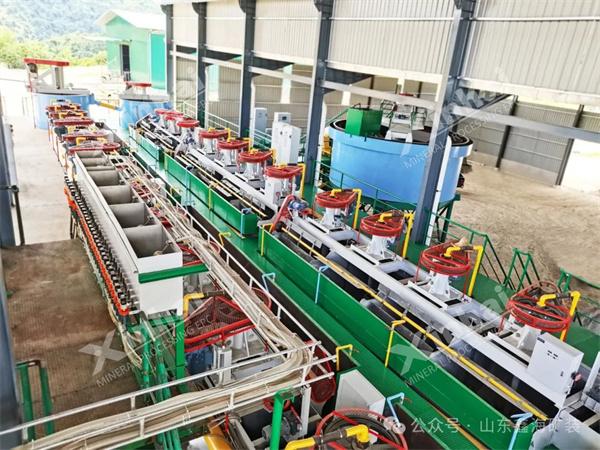Flotation is a commonly used method for copper-nickel ore beneficiation. Flotation can effectively separate valuable metals such as copper and nickel. Since the mineral composition of copper-nickel ore is relatively complex and the flotation methods of sulfide copper-nickel ore and oxide copper-nickel ore are different, this article introduces three commonly used flotation methods and their processes, and selects them according to the appropriate scenario.
(1) Principle
Direct preferential flotation method is to selectively capture and preferentially float a metal (usually copper or nickel) and achieve separation by utilizing the difference in the surface properties of the minerals. This method is suitable for ores with a copper content significantly higher than that of nickel.
(2) Flotation process
Roughing: Add collectors and frothers to the slurry to preferentially float copper minerals.
Fine selection: The copper concentrate obtained from roughing is finely selected multiple times to improve the copper grade.
Scavenging: The tailings are scavenged multiple times to recover the residual copper minerals.
(3) Applicable scenarios
Direct preferential flotation method is suitable for ores with a copper content significantly higher than that of nickel, such as ores with a copper-nickel ratio greater than 2:1. In this case, preferential flotation of copper can simplify the process and reduce the cost of reagents.
(4) Advantages and disadvantages
Advantages: Simple process, direct copper concentrate can be obtained, suitable for large-scale production.
Disadvantages: Nickel activation is difficult, the recovery rate is low, especially after the nickel minerals are suppressed, it is difficult to effectively recover.

(1) Principle
Mixed flotation is to float copper and nickel at the same time to obtain a mixed concentrate. This method simplifies the beneficiation steps by using a universal flotation agent.
(2) Flotation process
Mixed flotation: Add a universal collector (such as xanthate) to float copper and nickel minerals at the same time.
Mixed concentrate treatment: The obtained mixed concentrate is then separated and treated.
(3) Applicable scenarios
Mixed flotation is suitable for ores with a copper content lower than nickel, or ores with a more complex mineral symbiosis. This method is suitable for small-scale beneficiation plants and can reduce equipment investment costs.
(4) Advantages and disadvantages
Advantages: Simple process, suitable for small-scale beneficiation plants, high equipment utilization.
Disadvantages: The separation of mixed concentrate is more complicated, the concentrate grade is lower, and the subsequent treatment cost is higher.
(1) Principle
The mixed flotation followed by separation flotation method is to first carry out mixed flotation and then separate copper and nickel through reagents. This method achieves effective separation of copper and nickel by adjusting the pH of the slurry and adding inhibitors or activators.
(2) Process
Mixed flotation: Add universal collector to float copper and nickel minerals at the same time.
Separation flotation: By adding depressants such as lime and cyanide, copper minerals are floated preferentially, and nickel minerals remain in the tailings. If nickel needs to be recovered, the nickel ore can be reactivated by adding an activator (such as copper sulfate) and then flotation is performed.
(3) Applicable scenarios
The mixed flotation followed by separation flotation method is suitable for ores with complex copper-nickel symbiosis and high nickel content. This method can effectively improve the nickel recovery rate, especially when processing low-grade nickel ore.
(4) Advantages and disadvantages
Advantages: high nickel recovery rate, high equipment utilization rate, suitable for processing complex ores.
Disadvantages: The separation process is complicated, the cost of reagents is high, and the operation requirements are strict.
The above are the flotation methods commonly used in copper-nickel ore beneficiation. Before selecting the flotation method, a mineral processing test should be carried out and the mineral processing plan should be determined based on the test results to better complete the separation and extraction of copper and nickel, obtain high-grade copper concentrate and nickel concentrate, and improve the economic benefits of the mineral processing plant.